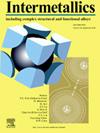CoCrFeNi 基高熵合金在老化温度过程中的显微结构演变和拉伸性能行为
IF 4.3
2区 材料科学
Q2 CHEMISTRY, PHYSICAL
引用次数: 0
摘要
了解高熵合金(HEA)的强化机制对于改善其机械性能至关重要。在本研究中,我们深入研究了 L12 纳米沉淀物对面心立方 (FCC) CoCrFeNi HEA 力学性能的强化作用。我们通过添加钛(Ti)、铌(Nb)和铝(Al)引入了 L12 纳米沉淀物。经过一系列热处理(分别在 400 ℃、600 ℃ 和 800 ℃ 下老化 4 小时)后,与钴铬镍基合金相比,在 800 ℃ 下老化的样品的拉伸强度有了明显提高,同时还保持了极佳的延展性(伸长率大于 29%)。性能的提高主要归功于多种强化机制的协同作用,其中沉淀强化的作用尤为突出(ΔσP=385.6MPa)。透射电子显微镜(TEM)结果显示,L12 沉淀的体积分数达到 35%,大小约为 12 纳米。这项研究为优化高熵合金的成分和加工策略提供了宝贵的理论见解,为开发适用于复杂工程应用的高性能合金奠定了坚实的基础。本文章由计算机程序翻译,如有差异,请以英文原文为准。
Microstructure evolution and tensile properties behavior during aging temperature of CoCrFeNi-based high entropy alloys
Understanding the strengthening mechanism of high entropy alloys (HEA) is vital to improve their mechanical properties. In this study, we thoroughly investigated the strengthening effect of L12 nanoprecipitates on the mechanical properties of the face-centered cubic (FCC) CoCrFeNi HEA. The L12 nanoprecipitates were introduced by adding titanium (Ti), niobium (Nb), and aluminum (Al). Following a series of heat treatments (aged at 400 °C, 600 °C, and 800 °C for 4 h), the samples aged at 800 °C exhibited a noticeable improvement in tensile strength compared to the CoCrFeNi-based alloy, while maintaining excellent ductility (elongation greater than 29 %). This enhanced in performance is primarily attributed to the synergistic effects of multiple strengthening mechanisms, with precipitation strengthening playing a particularly prominent role (. Transmission electron microscopy (TEM) results revealed that the volume fraction of L12 precipitates reached 35 %, with sizes around 12 nm. This study provides valuable theoretical insights for optimizing the composition and processing strategies of high entropy alloys and lays a solid foundation for the development of high-performance alloys suited to complex engineering applications.
求助全文
通过发布文献求助,成功后即可免费获取论文全文。
去求助
来源期刊

Intermetallics
工程技术-材料科学:综合
CiteScore
7.80
自引率
9.10%
发文量
291
审稿时长
37 days
期刊介绍:
This journal is a platform for publishing innovative research and overviews for advancing our understanding of the structure, property, and functionality of complex metallic alloys, including intermetallics, metallic glasses, and high entropy alloys.
The journal reports the science and engineering of metallic materials in the following aspects:
Theories and experiments which address the relationship between property and structure in all length scales.
Physical modeling and numerical simulations which provide a comprehensive understanding of experimental observations.
Stimulated methodologies to characterize the structure and chemistry of materials that correlate the properties.
Technological applications resulting from the understanding of property-structure relationship in materials.
Novel and cutting-edge results warranting rapid communication.
The journal also publishes special issues on selected topics and overviews by invitation only.
 求助内容:
求助内容: 应助结果提醒方式:
应助结果提醒方式:


